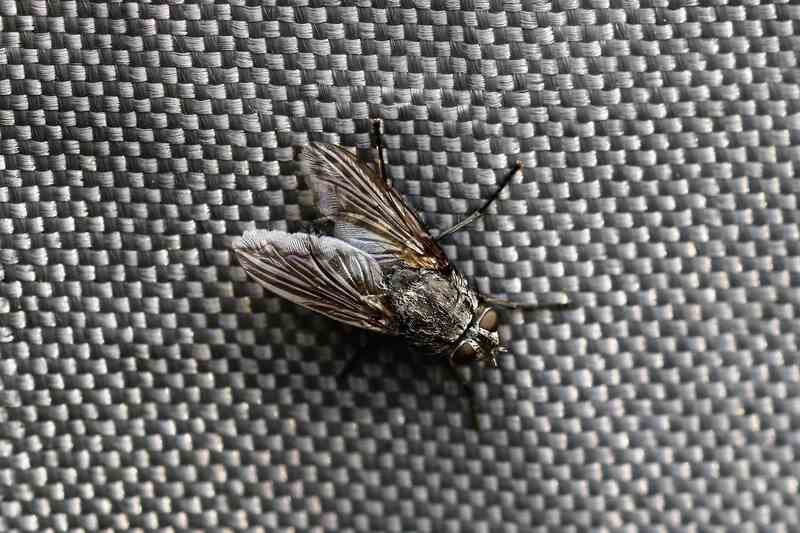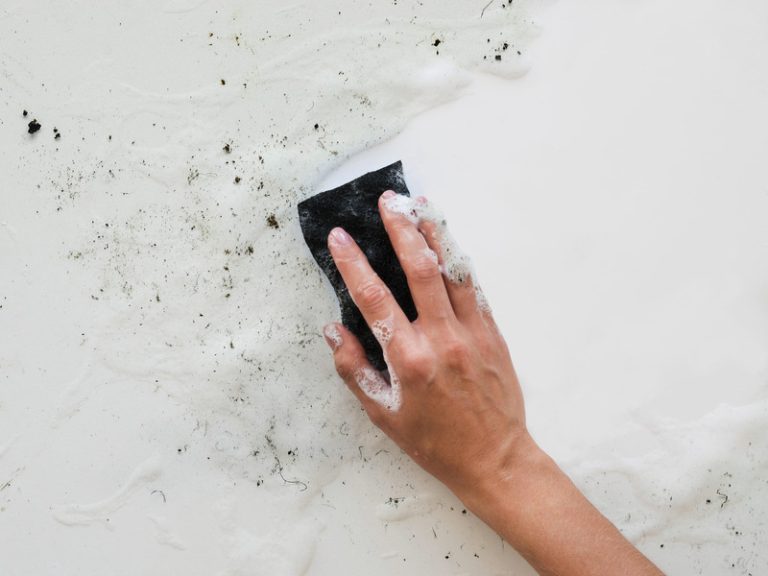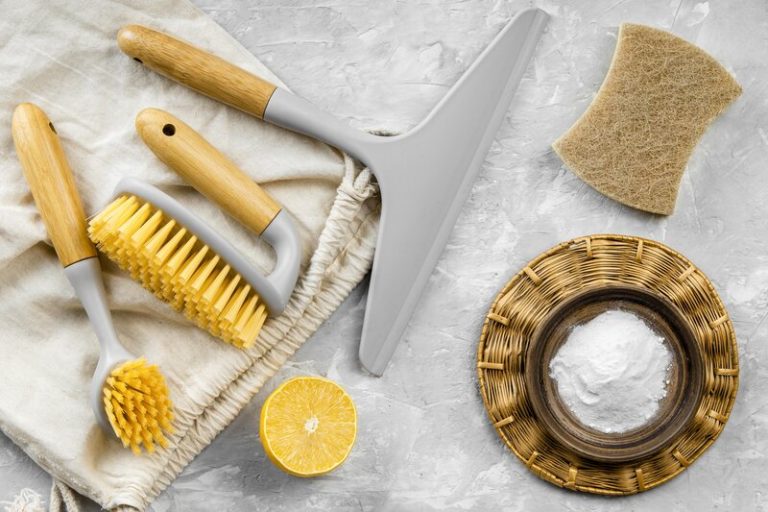As we know, apart from being a nuisance to homeowners, carpet moths can also cause damage to carpets and other woollen materials in the house. However, do you know what are the signs of carpet moths?
Today, we will explore the signs of carpet moths, from the shape and visible damage to the musty smell, we cover it all.
Learn the signs of carpet moths, how to inspect, eradicate and prevent carpet moths from invading your home in this article!
What Do Carpet Moths Look Like?
Before discussing the signs of carpet moths further, of course you need to know first what this animal looks like.
Adult carpet moths are small, typically measuring around 5-8 mm in length, with brownish-grey wings that feature faint, dark specks, distinguishing them from Carpet Beetles.
Plus their size and colour, carpet moths are known for their powdery appearance, often mistaken for tiny patches of dust. Their larvae, which are the real nuisance, are creamy-white caterpillars with a golden-brown head.
These pests can cause considerable damage to carpets and other natural fibres, feeding on wool, fur, silk, and even feathers. Unlike Carpet Beetles, carpet moths do not possess a hardened shell, making them more challenging to eradicate once infested.
What Are the Signs of Carpet Moths?
Identifying a carpet moth infestation early is crucial, and common signs include:
a. Visible Damage to Carpet
Visible damage to carpets, such as irregular holes or thinning patches, is often one of the first signs of a carpet moth infestation, as the larvae feed on keratin found in natural fibres.
Carpet moths can wreak havoc on various types of carpets, including wool, silk, and even synthetic blends. Wool carpets are particularly susceptible due to their natural fibres that provide an ideal feast for the moth larvae. Silk carpets, prized for their luxurious feel, can also fall victim to these pests.
Identifying the damage caused by carpet moths involves looking for specific patterns, such as holes clustered in one area or a gradual thinning of the carpet pile. In severe cases, the damage may extend to the carpet backing or even nearby clothing items made of similar materials.
b. Presence of Adult Moths
The presence of adult moths fluttering around your home, particularly in dimly lit areas, is another clear indicator of a carpet moth infestation.
Adult moths are often seen during the evening or night when they are most active. They are commonly found near stored fabrics, cupboards, and dark corners of rooms, where they lay their eggs. Adult moths themselves do not cause damage to fabrics, but it’s their larvae that feed on natural fibres like wool, silk, and fur, causing the infamous moth holes. Understanding the behaviour and life cycle of adult moths is crucial in identifying and effectively dealing with a potential pest infestation.
c. Larvae or Pupae in Carpet Fibres
Finding larvae or pupae among the carpet fibres is a sure sign of an infestation, as these stages of the moth’s life cycle are when they cause the most damage by feeding on natural fibres.
Generally, larvae can be identified as small, worm-like creatures with a soft body and a voracious appetite for fabric. They are usually off-white or cream-coloured and may leave behind silken webbing as they move around. Pupae, on the other hand, are cocooned in a protective casing and can often be mistaken for grains of rice. Their immobile nature makes them harder to spot.
To detect these pests in your carpets, thoroughly inspect areas near skirting boards, under furniture, and in dark, undisturbed corners. Regular vacuuming and steam cleaning can help remove larvae and pupae, disrupting their life cycle and preventing further damage.
d. Webbing or Cocoons in Carpet
Webbing or cocoons found within the carpet fibres or in hidden areas like under furniture can indicate the presence of carpet moths, as these are protective structures created during their development.
Carpet moth webbing typically appears as silken tunnels or patches in the affected areas, while the cocoons, resembling small oval casings, are where the larvae transform into adult moths. These structures serve as safe havens for the larvae to grow and complete their metamorphosis away from predators. The presence of webbing and cocoons is a clear sign of an infestation, signalling that the destructive cycle of egg-larvae-pupae-adult is underway within your carpets.
e. Musty Odour
A musty odour emanating from your carpets can be an indicator of a carpet moth infestation, often resulting from the accumulation of larvae, pupae, and their waste products.
When carpet moths infest a carpet, they lay eggs in secluded areas where food sources are abundant. These eggs hatch into larvae, which then feed on natural fibres such as wool and silk, causing damage to the carpet. As the larvae mature into pupae and eventually into adult moths, they leave behind faecal matter and shed skins, contributing to the musty smell that permeates the affected area.
How to Get Rid of Carpet Moths?
After knowing what are the signs of carpet moths, of course you also have to know how to get rid of them. Getting rid of carpet moths involves a multifaceted approach that includes:
a. Vacuuming Regularly
Regular vacuuming is essential in managing a carpet moth infestation, as it helps remove larvae, eggs, and infested items from the carpet fibres.
Besides removing existing moths and their eggs, vacuuming also eliminates debris and dust particles that can attract moths in the first place. By regularly vacuuming your carpets, rugs, and upholstery, you disrupt the life cycle of these pests, making it harder for them to establish a thriving population in your home.
b. Using Natural Repellents
Using natural repellents such as vinegar and other household solutions can be an effective and eco-friendly way to deter carpet moths from laying eggs in your carpets.
Aside from vinegar, there are several other natural repellents that can be utilised to combat carpet moths. Essential oils like lavender, cedar and peppermint have strong scents that can repel these pests effectively. You can create a homemade spray by mixing a few drops of these oils with water and spritzing it on your carpets. Diatomaceous earth, a natural sedimentary rock powder, can be sprinkled along the edges of carpets to create a barrier that deters carpet moths.
Another common household item that can serve as a natural repellent is cloves. Placing whole cloves in sachets or scattering them near affected areas can discourage moths from settling in. Regularly vacuuming your carpets and keeping them clean and dry also plays a significant role in preventing carpet moth infestations.
c. Professional Carpet Cleaning
Professional carpet cleaning services, provided by experts, can thoroughly eliminate carpet moths and their larvae, ensuring a deep clean that disrupts the infestation cycle.
When considering professional carpet cleaning, it is important to note the numerous benefits that come with it. Not only does it remove visible dirt and stains, but it also helps to improve air quality by eliminating allergens and bacteria trapped in the fibres. Professional cleaning methods, such as hot water extraction or dry cleaning, can effectively target pests like carpet moths, preventing further damage to your carpets.
d. Insecticides
Insecticides and sprays targeted specifically at carpet moths can effectively kill adult moths, larvae, and eggs, offering a powerful solution to severe infestations.
These specialised insecticides come in various forms, such as aerosols, powders, and concentrated liquids, providing options for different application preferences. Pyrethroid-based sprays are commonly used for their effectiveness against carpet moths without causing harm to humans and pets when used as directed.
When applying insecticides, it is crucial to thoroughly read and follow the instructions on the product label to ensure proper usage. It is recommended to target areas where moths are most active, such as cupboards, under furniture, and along skirting boards, to maximise the impact of treatment.
How to Prevent Carpet Moths?
Now that you know the signs of carpet moths and how to get rid of them, here are some preventive measures you can take to prevent their occurrence:
a. Regular Cleaning and Maintenance of Carpets
Regular cleaning and maintenance of carpets are crucial in preventing carpet moth infestations, as they remove potential food sources and disrupt the life cycle of the pests.
One effective tip is to vacuum your carpets regularly, at least once a week, to remove dirt, debris, and any moth eggs present.
Rotate furniture placements occasionally to expose different areas of the carpet to light and air, making the environment less favourable for moths to thrive. Consider steam cleaning your carpets annually to deep clean and sanitise, eliminating any hidden moth larvae or eggs.
By implementing these practices, you can significantly reduce the risk of carpet moth infestations and prolong the life of your carpets.
b. Proper Storage of Wool Items
Proper storage of woollen items, such as using airtight containers or vacuum-sealed bags, is essential in preventing carpet moths from accessing and infesting these textiles.
Avoiding storing woollens in damp or humid areas is crucial, as moisture can attract moths and contribute to the growth of larvae. It is also recommended to regularly clean and inspect stored woollen items, shaking them out in sunlight to deter moth activity. Incorporating natural moth repellents like cedar balls or lavender sachets in storage containers can provide an extra layer of protection.
c. Using Moth Traps
Using moth traps that contain pheromones can effectively capture and monitor the presence of carpet moths, helping to keep their population under control.
Pheromone traps work by emitting synthetic versions of the insect’s sex pheromones, luring adult male moths into the trap where they become stuck and unable to reproduce. These traps are highly targeted and species-specific, minimising harm to beneficial insects and the environment.
To use pheromone traps as part of a preventive strategy, it’s important to place them strategically in areas where moth activity is suspected, such as near stored clothing or fabrics.
From the explanation above, now you know what are the signs of carpet moths? In fact, now you also know how to eradicate and prevent its existence.
However, dealing with carpet moth infestations can be challenging without professional help. At TEKA Cleaning, we specialise in thorough carpet cleaning services that effectively eliminate carpet moths and their larvae, preventing further damage to your carpets.
Don’t let carpet moths ruin the beauty and integrity of your carpets. Contact TEKA Cleaning today at 01233 751 544 to schedule our expert carpet cleaning services. Trust our experienced team to provide a comprehensive clean that safeguards your carpets and ensures a healthy living environment.
Read also:











